Viscoelastic Property of an LDPE Melt in Triangular- and Trapezoidal-Loop Shear Experiment
Abstract
:1. Introduction
2. Materials and Methods
2.1. LDPE
2.2. Setup
2.3. Rivlin–Sawyers (RS) Model
2.4. Shear Strain and Stress in Trapezoidal-Loop
2.5. Viscoelastic Characterization of the LDPE Melt
3. Results and Discussion
3.1. Validation of the RS Model
3.2. Predictions of the Triangular-Loops
3.2.1. Short-Term Shear with t0 = 0.1 s
3.2.2. Medium-Term Shear with t0 = 10 s
3.2.3. Long-Term Shear with t0 = 40 s and 100 s
3.3. Predictions of the Trapezoidal-Loops
3.3.1. Short-Term Startup Shear with t0 = 1 s
3.3.2. Long-Term Startup Shear with t0 = 100 s
3.4. f Effect
3.5. Discussion on the Shear Weakening Behavior
4. Conclusions
Funding
Institutional Review Board Statement
Informed Consent Statement
Data Availability Statement
Conflicts of Interest
References
- Han, C.D. Rheology in Polymer Processing; Academic Press: New York, NY, USA, 1976. [Google Scholar]
- Meissner, J. Modifications of the weissenberg rheogoniometer for measurement of transient rheological properties of molten polyethylene under shear. comparison with tensile data. J. Appl. Polym. Sci. 1972, 16, 2677–2899. [Google Scholar] [CrossRef]
- Laun, H.M. Description of the non-linear shear behaviour of a low density polyethylene melt by means of an experimentally determined strain dependent memory function. Rheol. Acta 1978, 17, 1–15. [Google Scholar] [CrossRef]
- Laun, H.M. Prediction of elastic strains of polymer melts in shear and elongation. J. Rheol. 1986, 30, 459–501. [Google Scholar] [CrossRef]
- Wagner, M.H.; Rubio, P.; Bastian, H. The molecular stress function model for polydisperse polymer melts with dissipative convective constraint release. J. Rheol. 2001, 45, 1387–1412. [Google Scholar] [CrossRef]
- Bastian, H. Non-Linear Viscoelasticity of Linear and Long-Chain Branched Polymer Melts in Shear and Extensional Flows. Ph.D. Thesis, University of Stuttgart, Stuttgart, Germany, 2001. [Google Scholar]
- Pivokonsky, R.; Zatloukal, M.; Filip, P. On the predictive/fitting capabilities of the advanced differential constitutive equations for branched LDPE melts. J. Non-Newton. Fluid Mech. 2006, 135, 58–67. [Google Scholar] [CrossRef]
- Li, B.; Yu, W.; Cao, X.; Chen, Q. Horizontal extensional rheometry (HER) for low viscosity polymer melts. J. Rheol. 2020, 64, 177–190. [Google Scholar] [CrossRef]
- Zatloukal, M. Differential viscoelastic constitutive equations for polymer melts in steady shear and elongational flows. J. Non-Newton. Fluid Mech. 2003, 113, 209–227. [Google Scholar] [CrossRef]
- Pivokonsky, R.; Zatloukal, M.; Filip, P. On the predictive/fitting capabilities of the advanced differential constitutive equations for linear polyethylene melts. J. Non-Newton. Fluid Mech. 2008, 150, 56–64. [Google Scholar] [CrossRef]
- Konagantia, V.K.; Ansaria, M.; Mitsoulis, E.; Hatzikiriakos, S.G. Extrudate swell of a high-density polyethylene melt: II. Modeling using integral and differential constitutive equations. J. Non-Newton. Fluid Mech. 2015, 225, 94–105. [Google Scholar] [CrossRef]
- Morelly, S.L.; Alvarez, N.J. Characterizing long-chain branching in commercial HDPE samples via linear viscoelasticity and extensional rheology. Rheol. Acta 2020, 59, 797–807. [Google Scholar] [CrossRef]
- Pivokonsky, R.; Zatloukal, M.; Filip, P.; Tzoganakis, C. Rheological characterization and modeling of linear and branched metallocene polypropylenes prepared by reactive processing. J. Non-Newton. Fluid Mech. 2009, 156, 1–6. [Google Scholar] [CrossRef]
- Zhang, X.; Li, H.; Chen, W.; Feng, L. Rheological properties and morphological evolutions of polypropylene/ethylene-butene copolymer blends. Polym. Eng. Sci. 2012, 52, 1740–1748. [Google Scholar] [CrossRef]
- Drabek, J.; Zatloukal, M. Evaluation of thermally induced degradation of branched polypropylene by using rheology and different constitutive equations. Polymers 2016, 8, 317. [Google Scholar] [CrossRef] [Green Version]
- Costanzo, S.; Huang, Q.; Ianniruberto, G.; Marrucci, G.; Hassager, O.; Vlassopoulos, D. Shear and extensional rheology of polystyrene melts and solutions with the same number of entanglements. Macromolecules 2016, 49, 3925–3935. [Google Scholar] [CrossRef] [Green Version]
- Laun, H.M.; Schmidt, G. Rheotens tests and viscoelastic simulations related to high-speed spinning of Polyamide 6. J. Non-Newton. Fluid Mech. 2015, 222, 45–55. [Google Scholar] [CrossRef]
- Rolon-Garrido, V.H.; Pivokonsky, R.; Filip, P.; Zatloukal, M.; Wagner, M.H. Rheological characterization and constitutive modeling of two LDPE melts. AIP Conf. Proc. 2009, 1152, 32–43. [Google Scholar]
- Pivokonsky, R.; Filip, P. Predictive/fitting capabilities of differential constitutive models for polymer melts–reduction of nonlinear parameters in the eXtended Pom-Pom model. Colloid. Polym. Sci. 2014, 292, 2753–2763. [Google Scholar] [CrossRef]
- Pladis, P.; Meimaroglou, D.; Kiparissides, C. Prediction of the viscoelastic behavior of low-density polyethylene produced in high-pressure tubular reactors. Macromol. React. Eng. 2015, 9, 271–284. [Google Scholar] [CrossRef]
- Yang, J.; Fan, L.; Dai, Y. Modified single-mode Leonov rheological equations for polymer melts and solutions. J. Macromol. Sci. Part B-Phys. 2015, 54, 424–432. [Google Scholar] [CrossRef]
- Poh, L.; Li, B.; Yu, W.; Narimissa, E.; Wagner, M.H. Modeling of nonlinear extensional and shear rheology of low-viscosity polymer melts. Polym. Eng. Sci. 2021, 61, 1077–1086. [Google Scholar] [CrossRef]
- Luo, X.L.; Tanner, R.I. Finite element simulation of long and short circular die extrusion experiments using integral models. Int. J. Numer. Meth. Eng. 1988, 25, 9–22. [Google Scholar] [CrossRef]
- Goublomme, A.; Draily, B.; Crochet, M.J. Numerical prediction of extrudate swell of a high-density polyethylene. J. Non-Newton. Fluid Mech. 1992, 44, 171–195. [Google Scholar] [CrossRef]
- Groublomme, A.; Crochet, M.J. Numerical prediction of extrudate swell of a high-density polyethylene: Further results. J. Non-Newton. Fluid Mech. 1993, 47, 281–287. [Google Scholar] [CrossRef]
- Huang, S.X.; Lu, C.J. Stress relaxation characteristic and extrudate swell of the IUPAC-LDPE melt. J. Non-Newton. Fluid Mech. 2006, 136, 147–156. [Google Scholar] [CrossRef]
- Cao, W.; Shen, Y.; Wang, P.; Yang, H.; Zhao, S.; Shen, C. Viscoelastic modeling and simulation for polymer melt flow in injection/compression molding. J. Non-Newton. Fluid Mech. 2019, 274, 104186. [Google Scholar] [CrossRef]
- Barborik, T.; Zatloukal, M. Steady-state modeling of extrusion cast film process, neck-in phenomenon, and related experimental research: A review. Phys. Fluids 2020, 32, 061302. [Google Scholar] [CrossRef]
- Huang, S.; Lu, C. The non-linear and time-dependent rheological characteristic for a LDPE melt and its description. Acta Polym. Sin. 2004, 3, 339–344. (In Chinese) [Google Scholar]
- Fang, B.; Jiang, T. A novel constitutive equation for viscoelastic-thixotropic fluids and its application in the characterization of blood hysteresis loop. Chin. J. Chem. Eng. 1998, 6, 264–270. [Google Scholar]
- Huang, S.; Lu, C. The descriptions of viscoelastic for a LDPE melt by using Wagner equation and the predictions on its non-linear and time-dependent characteristic. Acta Polym. Sin. 2004, 6, 818–825. (In Chinese) [Google Scholar]
- Huang, S.; Lu, C. The characterization on the time-dependent nonlinear viscoelastic of a LDPE melt by using a simple thixotropy model. Acta Mech. Sin. 2005, 21, 330–335. [Google Scholar] [CrossRef]
- Huang, S.; Lu, C.; Fan, Y. The time-dependent viscoelastic of an LDPE melt. Acta Mech. Sin. 2006, 22, 199–206. [Google Scholar] [CrossRef]
- Huang, S.; Lu, C. Characterizations on the thixotropy-loop tests using UCM model with a rate-type kinetic equation. Chin. J. Polym. Sci. 2006, 24, 609–617. [Google Scholar] [CrossRef]
- Huang, S.; Lu, C. The thixotropy-loop behaviors of an LDPE melt: Experiment and simple analysis. J. Hydrodyn. 2006, 18, 666–675. [Google Scholar] [CrossRef]
- Greener, J.; Connelly, R.W. The response of viscoelastic liquids to complex strain histories: The thixotropic loop. J. Rheol. 1986, 30, 285–300. [Google Scholar] [CrossRef]
- Rivlin, R.S.; Sawyers, K.N. Nonlinear continuum mechanics of viscoelastic fluids. Annu. Rev. Fluid Mech. 1971, 3, 117–146. [Google Scholar] [CrossRef]
- Bird, R.B.; Armstrong, R.C.; Hassager, O. Dynamics of Polymeric Fluids, Volume 1. Fluid Mechanics, 2nd ed.; Wiley: New York, NY, USA, 1987. [Google Scholar]
- Meister, B.J. An integral constitutive equation based on molecular network theory. Trans. Soc. Rheol. 1971, 15, 63–89. [Google Scholar] [CrossRef]
- Huang, S. Viscoelastic characterization and prediction of a wormlike micellar solution. Acta Mech. Sin. 2021. [Google Scholar] [CrossRef]
- Huang, S. Viscoelastic characterization of the mucus from the skin of loach. Korea-Aust. Rheol. J. 2021, 33, 1–9. [Google Scholar] [CrossRef]
- Huang, S. Structural viscoelasticity of a water-soluble polysaccharide extract. Int. J. Biol. Macromol. 2018, 120, 1601–1609. [Google Scholar] [CrossRef]
- Kalyon, D.M.; Gevgilili, H. Wall slip and extrudate distortion of three polymer melts. J. Rheol. 2003, 47, 683–699. [Google Scholar] [CrossRef]
- Osaki, K.; Inoue, T.; Isomura, T. Stress overshoot of polymer solutions at high rates of shear. J. Polym. Sci. Part B-Polym. Phys. 2000, 38, 2043–2050. [Google Scholar] [CrossRef]
- Yziquel, F.; Carreau, P.J.; Moan, M.; Tanguy, P.A. Rheological modeling of concentrated colloidal suspensions. J. Non-Newton. Fluid Mech. 1999, 86, 133–155. [Google Scholar] [CrossRef]
- Acierno, D.; La Mantia, F.P.; Marrucci, G.; Titomanlio, G. A nonlinear viscoelastic model with structure-dependent relaxation times: I. basic formulation. J. Non-Newton. Fluid Mech. 1976, 1, 125–145. [Google Scholar] [CrossRef]
- Santangelo, P.G.; Roland, C.M. Interrupted shear flow of unentangled polystyrene melts. J. Rheol. 2001, 45, 583–594. [Google Scholar] [CrossRef] [Green Version]
- Hanson, D.E. Shear modification of polythene. Polym. Eng. Sci. 1969, 9, 405–413. [Google Scholar] [CrossRef]
- Rudin, A.; Schreiber, H.P. Shear modification of polymers. Polym. Eng. Sci. 1983, 23, 422–430. [Google Scholar] [CrossRef]
- Leblans, P.J.R.; Bastiaansen, C. Shear modification of low-density polyethylene: Its origin and its effect on the basic rheological functions of the melt. Macromolecules 1989, 22, 3312–3317. [Google Scholar] [CrossRef]
- Van Prooyen, M.; Bremner, T.; Rudin, A. Mechanism of shear modification of low density polyethylene. Polym. Eng. Sci. 1994, 34, 570–579. [Google Scholar] [CrossRef]

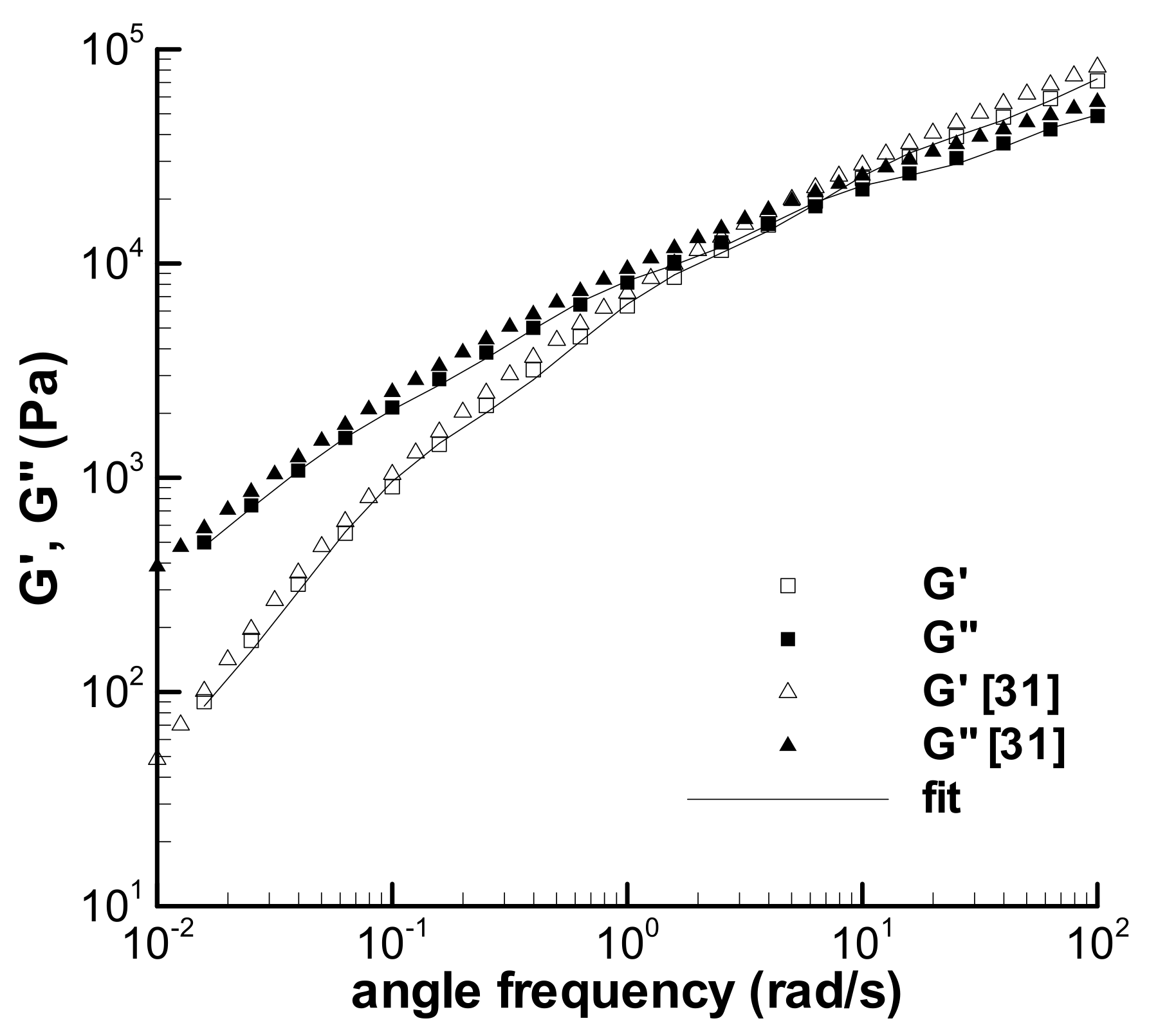
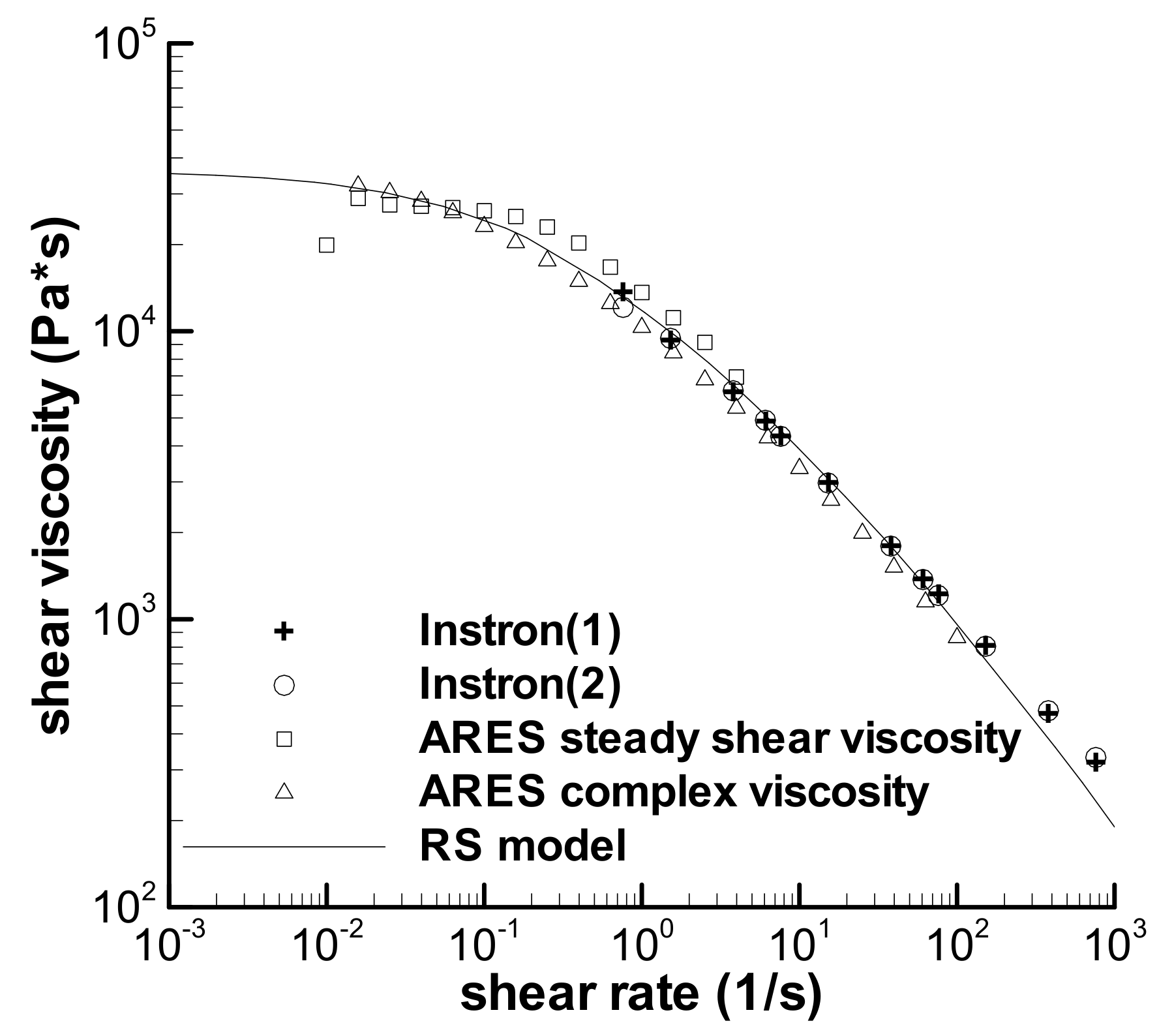

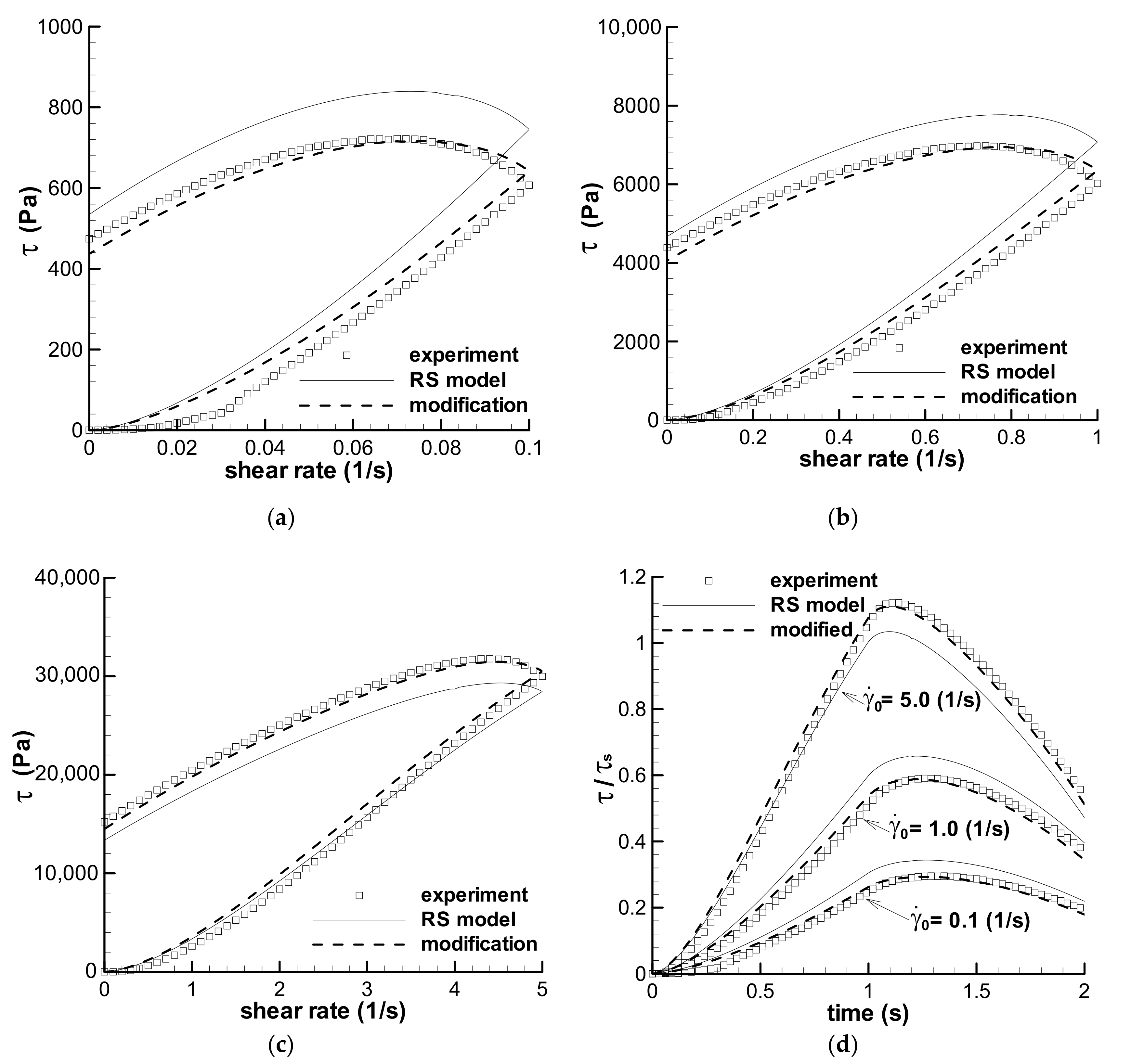
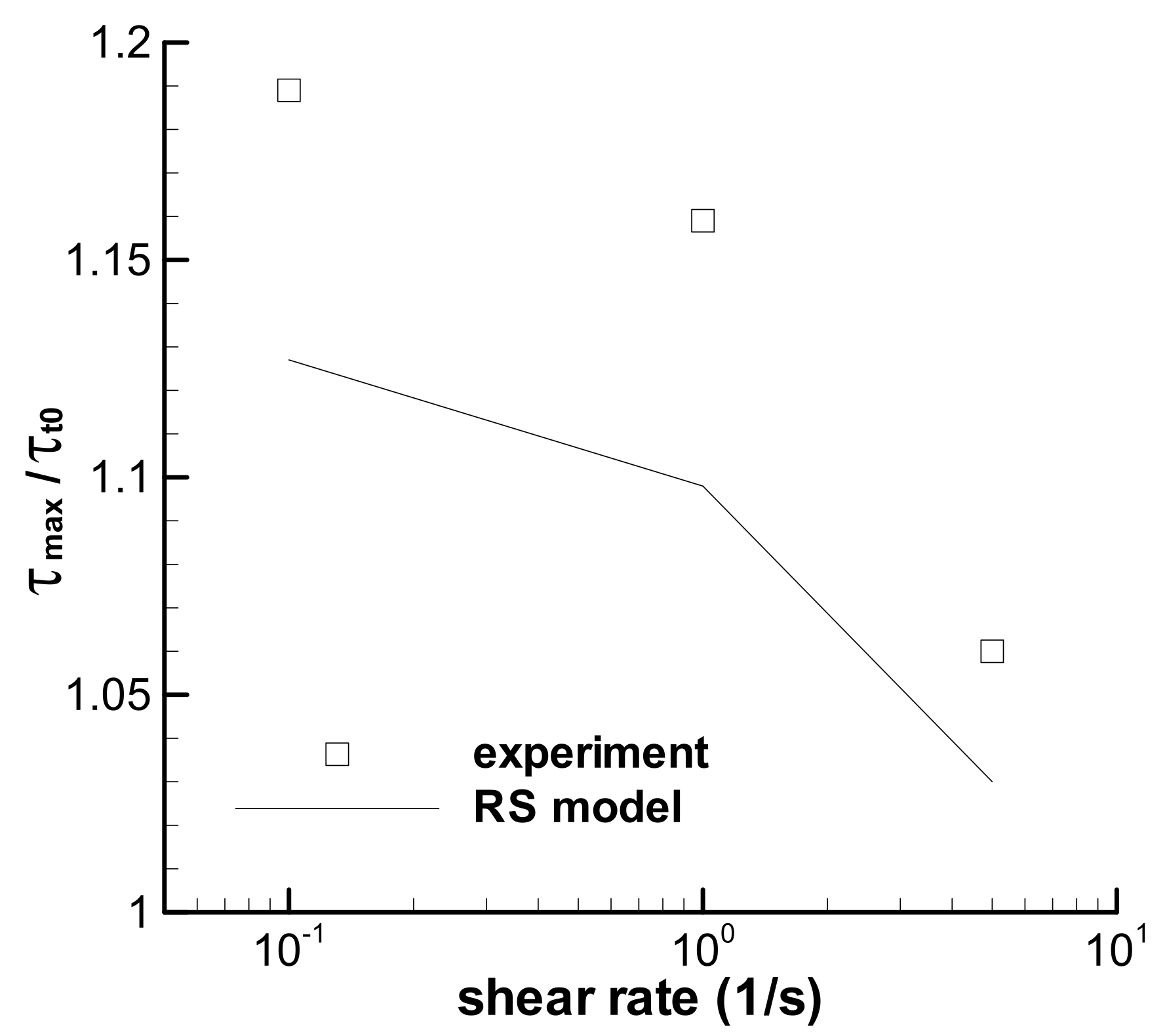
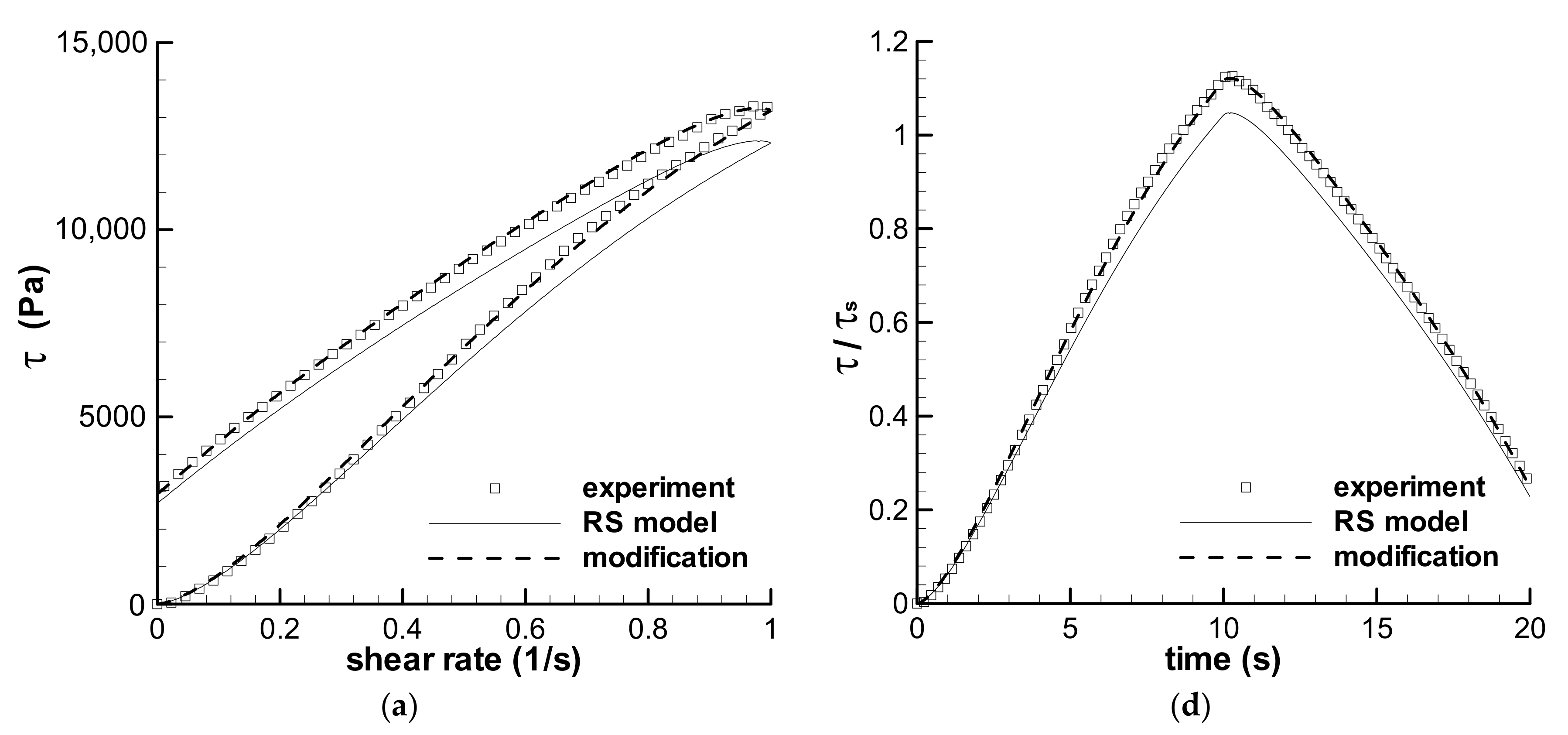
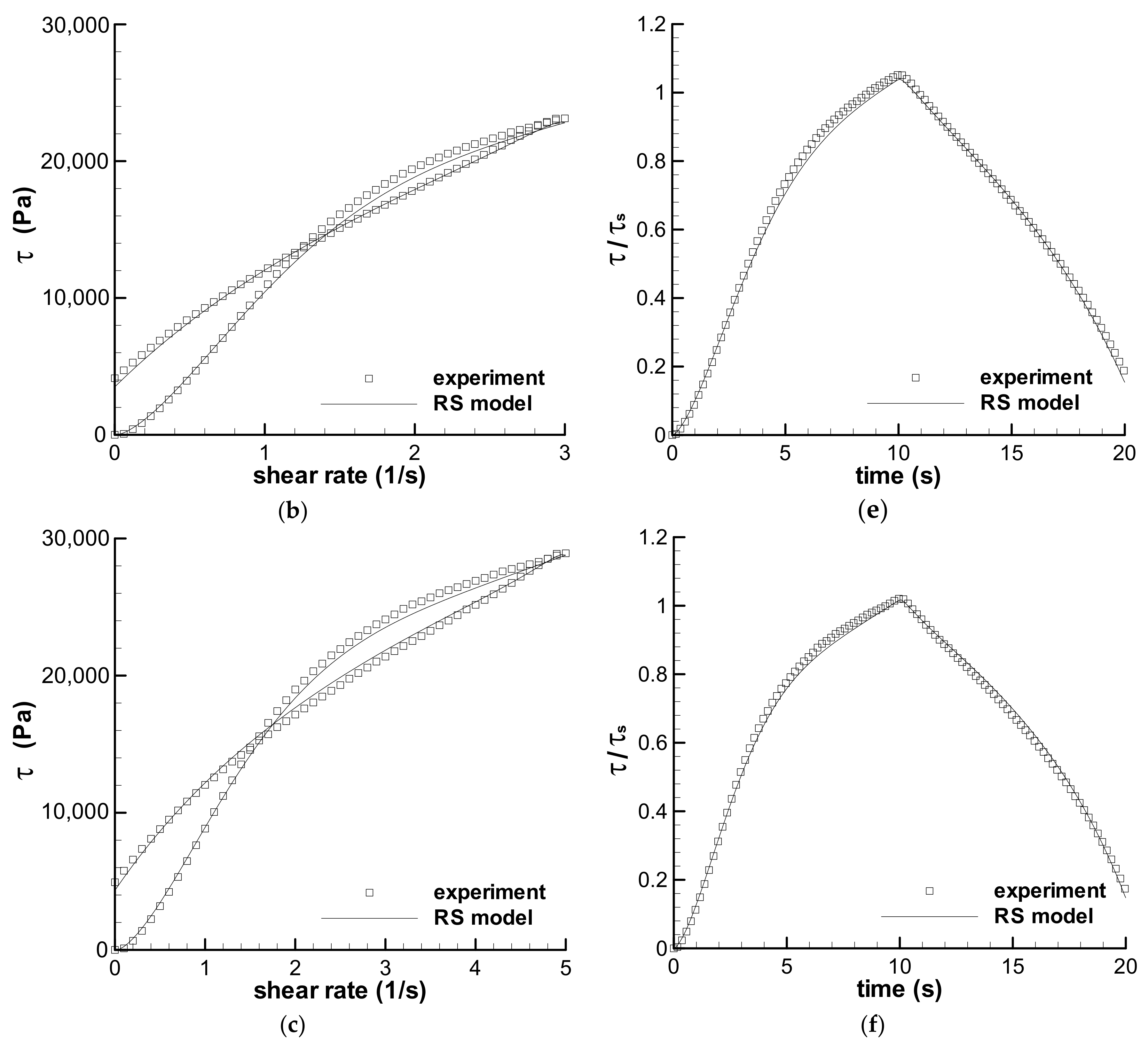
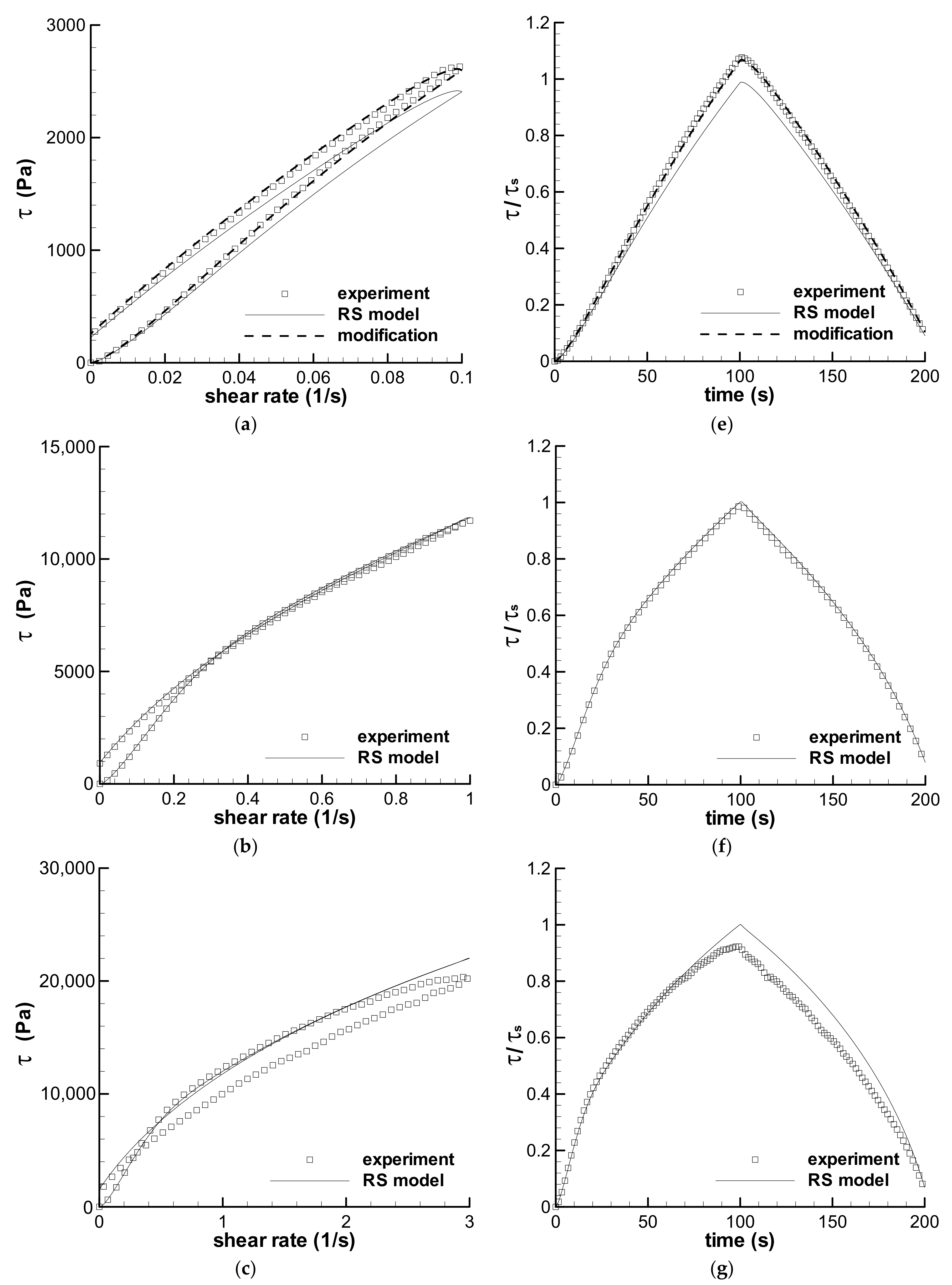
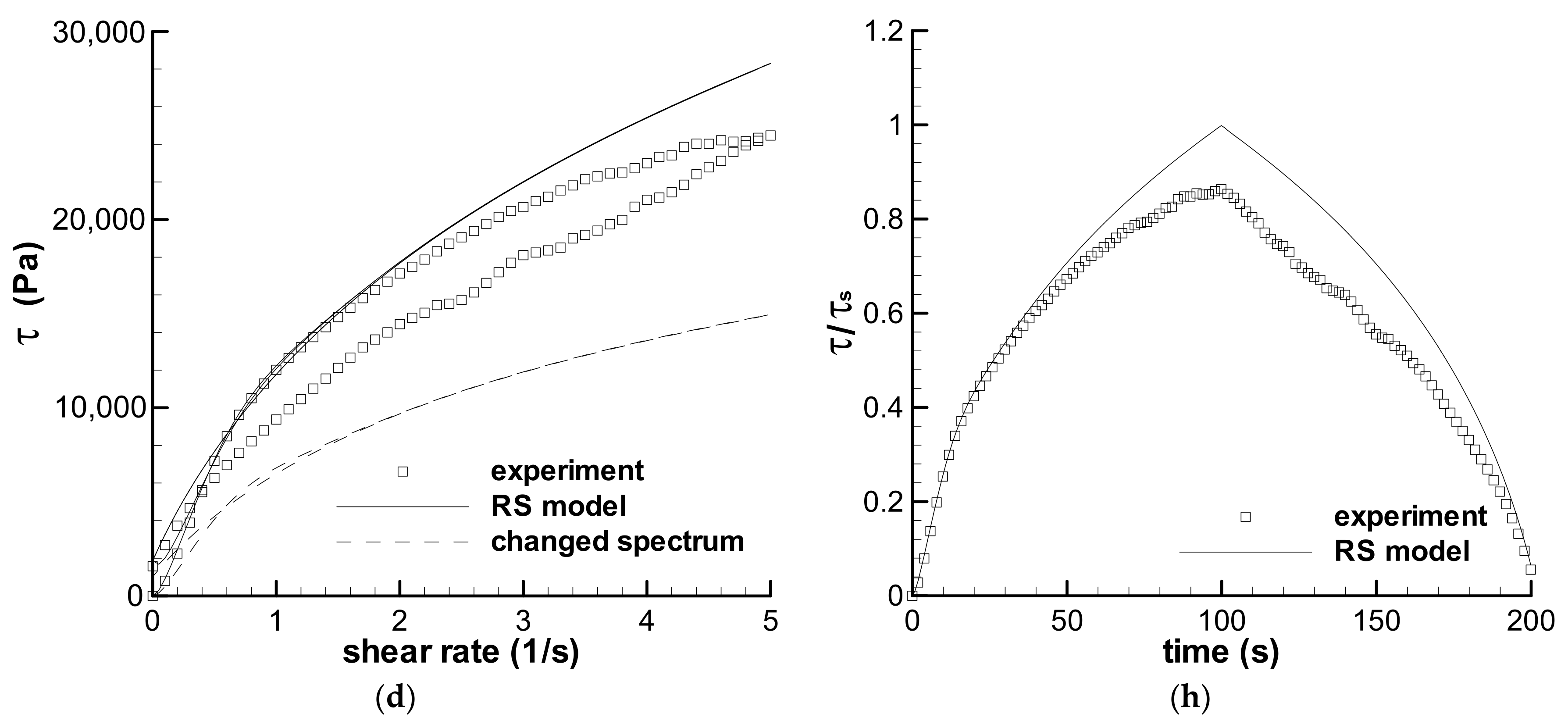

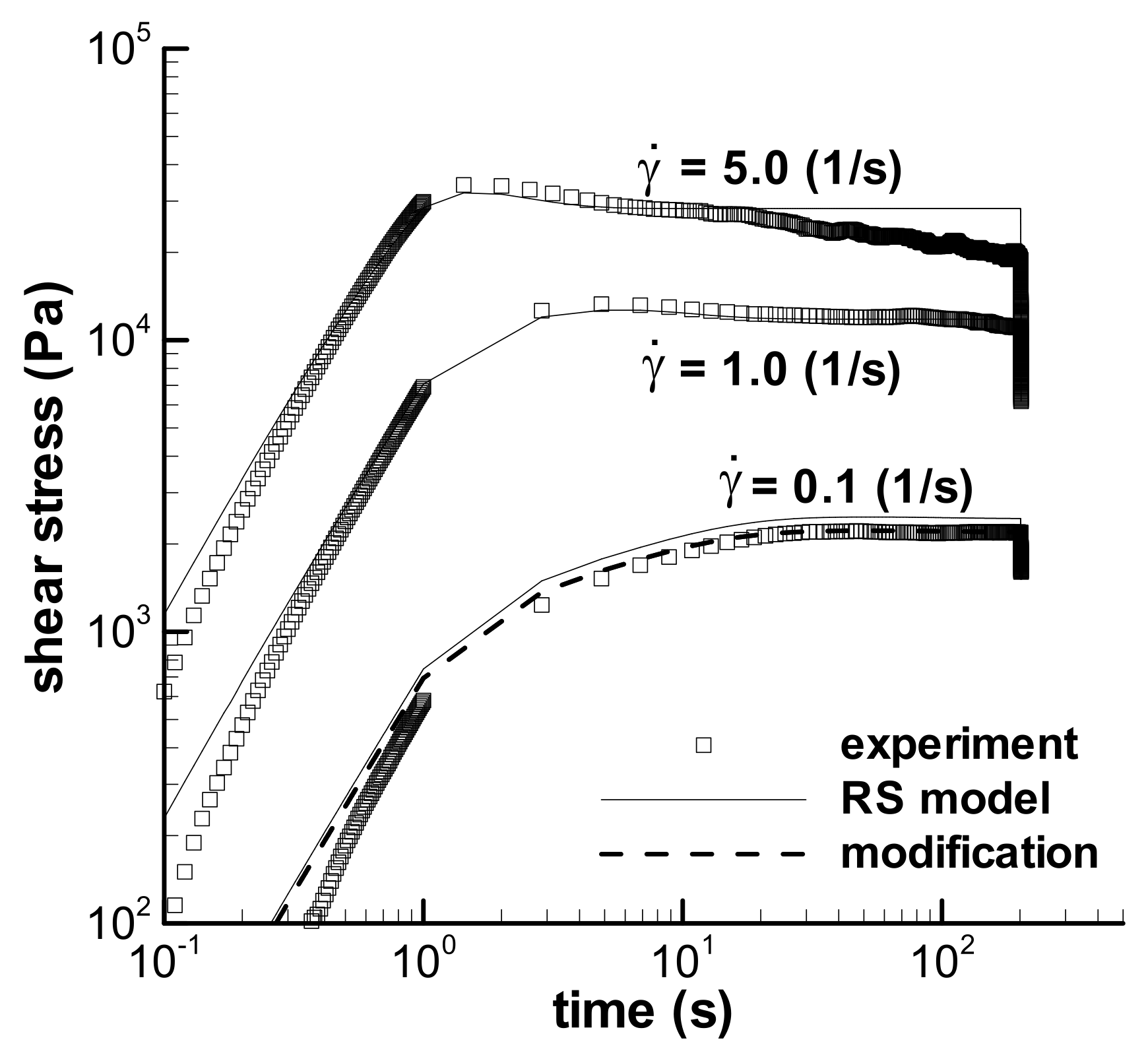
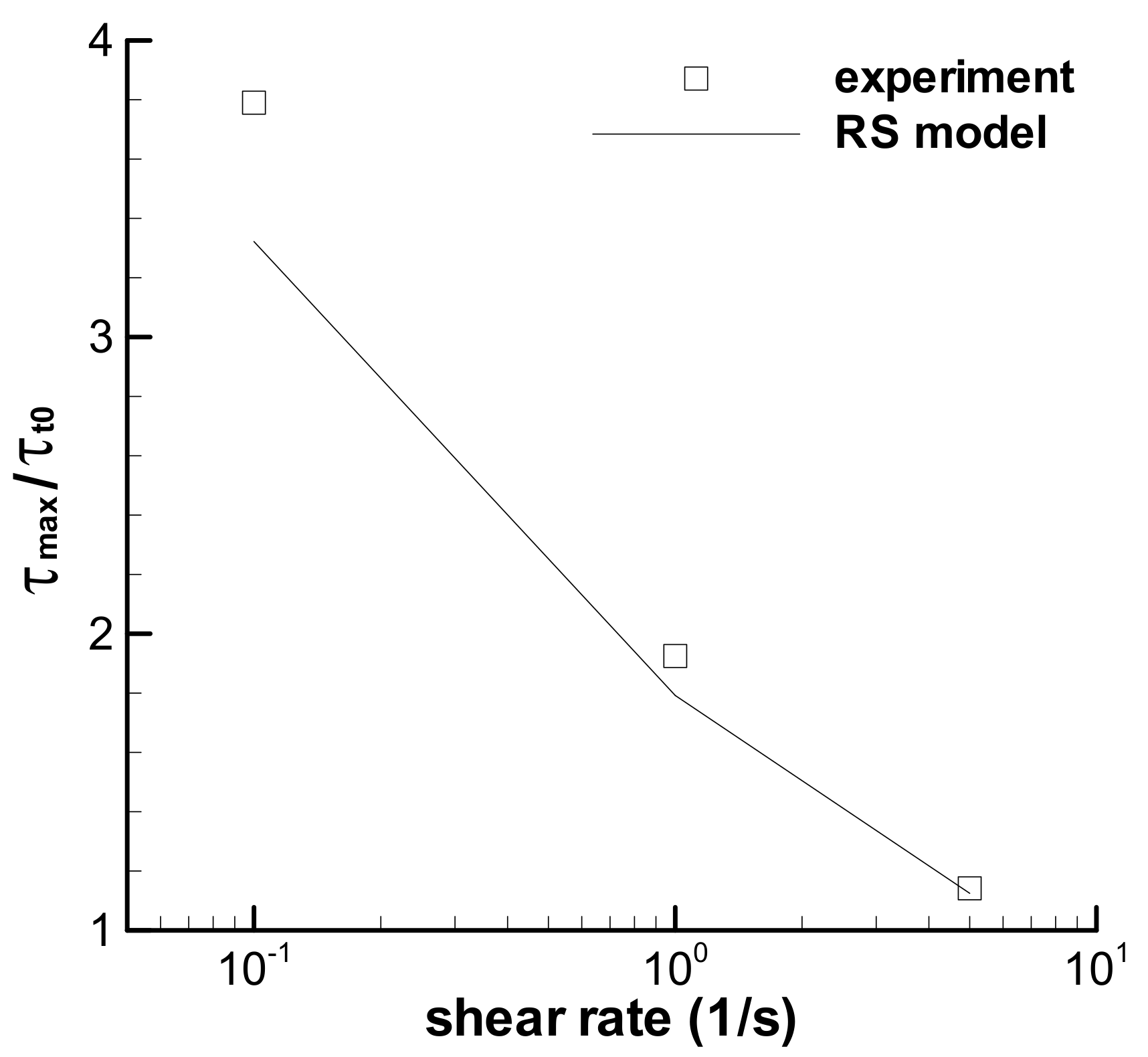


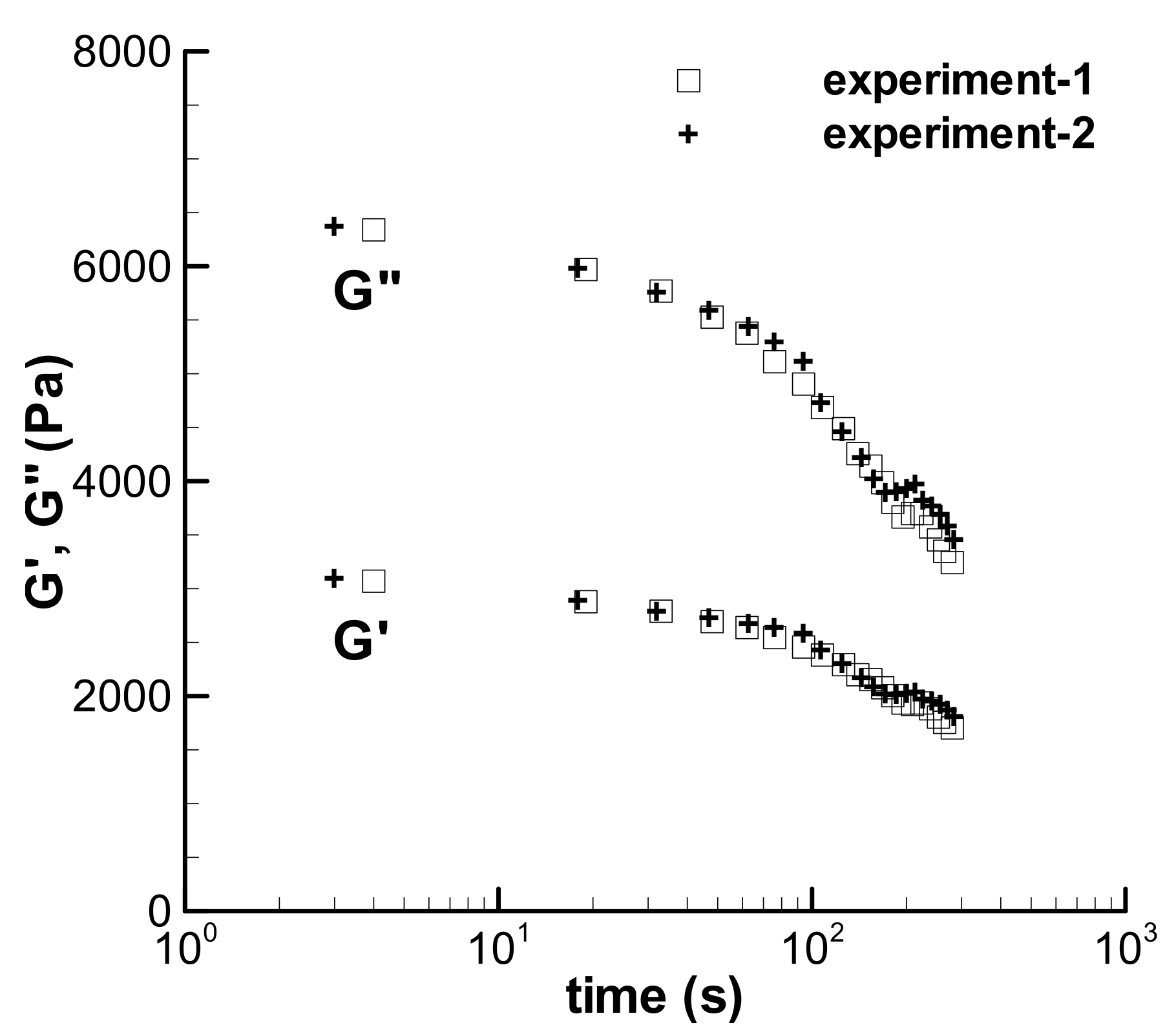

| Material | MFI (g/10 min, 190 °C) | Density (g/cm3) | Mw (g/mol) | Mn (g/mol) | Mw/Mn |
|---|---|---|---|---|---|
| LDPE-Q200 | 2 | 0.922 | 94,003 | 9719 | 9.672 |
| i | λi (s) | Present Work | Ref. [31] |
|---|---|---|---|
| gi (Pa) | gi (Pa) | ||
| 1 | 10−4 | 2.236 × 105 | 1.420 × 106 |
| 2 | 10−3 | 1.177 × 105 | 0 |
| 3 | 10−2 | 6.524 × 104 | 7.941 × 104 |
| 4 | 10−1 | 2.862 × 104 | 3.288 × 104 |
| 5 | 100 | 9.025 × 103 | 1.051 × 104 |
| 6 | 101 | 1.620 × 103 | 1.991 × 103 |
| 7 | 102 | 6.000 × 101 | 3.000 × 101 |
| 8 | 103 | 1.000 × 100 | 1.000 × 100 |
| i | λi (s) | gi (Pa) |
|---|---|---|
| 1 | 0.0001 | 25.4 |
| 2 | 0.001 | 84.5 |
| 3 | 0.01 | 7.9 |
| 4 | 0.032 | 7.552 |
| 5 | 0.1 | 4.8 |
| 6 | 0.32 | 3.68 |
| 7 | 1 | 2.06 |
| 8 | 3.2 | 1.0752 |
| 9 | 10 | 0.41 |
| 10 | 32 | 0.1376 |
| 11 | 100 | 0.0076 |
| Experiments | f |
|---|---|
| Triangular loop ( = 0.1 s−1, t0 = 1 s) [35] | 0.758 |
| Triangular loop ( = 1 s−1, t0 = 1 s) [35] | 0.819 |
| Triangular loop ( = 5 s−1, t0 = 1 s) [35] | 1.145 |
| Triangular loop ( = 1 s−1, t0 = 10 s) [35] | 1.114 |
| Triangular loop ( = 0.1 s−1, t0 = 100 s) [35] | 1.102 |
| Trapezoidal loop ( = 0.1 s−1, t0 = 1 s, t1 = 200 s) [35] | 0.875 |
| Trapezoidal loop ( = 0.1 s−1, t0 = 100 s, t1 = 200 s) [35] | 0.899 |
| Frequency sweep in SAOS [31] 1 | 1.314 |
| i | λi (s) | gi (Pa) |
|---|---|---|
| 1 | 10−4 | 2.207 × 105 |
| 2 | 5 × 10−3 | 5.173 × 104 |
| 3 | 5 × 10−2 | 1.409 × 104 |
| 4 | 10−1 | 6.016 × 103 |
| 5 | 100 | 5.802 × 103 |
| 6 | 1.3 × 101 | 8.030 × 102 |
| 7 | 102 | 4.700 × 101 |
| 8 | 103 | 3.000 × 100 |
Publisher’s Note: MDPI stays neutral with regard to jurisdictional claims in published maps and institutional affiliations. |
© 2021 by the author. Licensee MDPI, Basel, Switzerland. This article is an open access article distributed under the terms and conditions of the Creative Commons Attribution (CC BY) license (https://creativecommons.org/licenses/by/4.0/).
Share and Cite
Huang, S. Viscoelastic Property of an LDPE Melt in Triangular- and Trapezoidal-Loop Shear Experiment. Polymers 2021, 13, 3997. https://doi.org/10.3390/polym13223997
Huang S. Viscoelastic Property of an LDPE Melt in Triangular- and Trapezoidal-Loop Shear Experiment. Polymers. 2021; 13(22):3997. https://doi.org/10.3390/polym13223997
Chicago/Turabian StyleHuang, Shuxin. 2021. "Viscoelastic Property of an LDPE Melt in Triangular- and Trapezoidal-Loop Shear Experiment" Polymers 13, no. 22: 3997. https://doi.org/10.3390/polym13223997
APA StyleHuang, S. (2021). Viscoelastic Property of an LDPE Melt in Triangular- and Trapezoidal-Loop Shear Experiment. Polymers, 13(22), 3997. https://doi.org/10.3390/polym13223997






